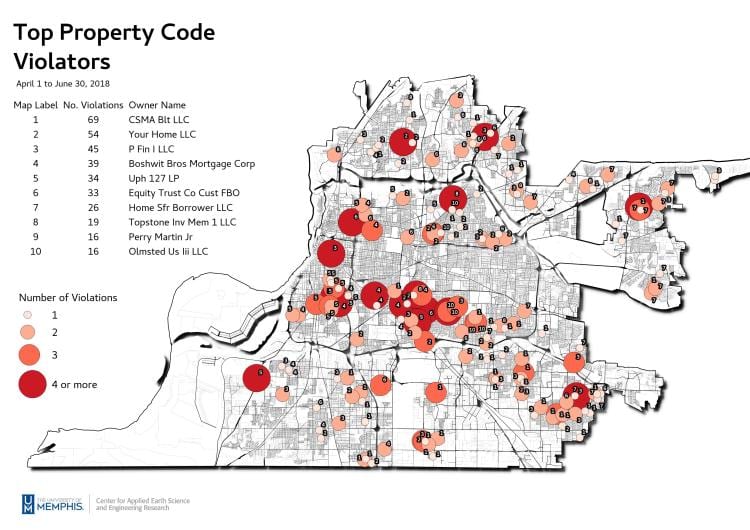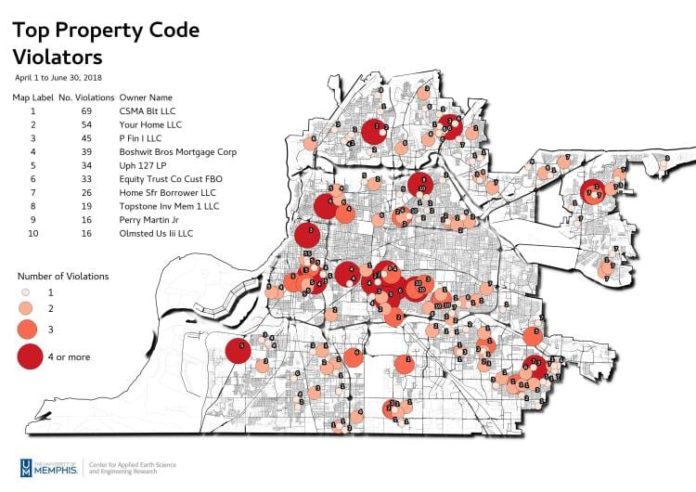By Andy Meek, High Grouund News
A new strategy is emerging in the fight against blight in Memphis, a perennial challenge that requires boots on the ground and the coordination of a nexus of public and private stakeholders. Some of the key players in the local fight are also building out what amounts to a data-gathering operation, and developing what will eventually be granular profiles on neighborhoods across the city.
Armed with a holistic picture of blight in Memphis neighborhoods, local leaders can get ahead of problem properties and keep cleanup crews and code enforcement teams from feeling like they’re left to essentially play a game of whack-a-mole, attacking blight piecemeal as they find it.
In-depth, multi-faceted data aggregated at the neighborhood level doesn’t currently exist at this scale, and the effort is potentially game-changing for city and county officials, municipal agencies, neighborhood groups, community development corporations and others working in the field. And while it might look like a tedium of number crunching and spreadsheets, but data is arguably more important than bulldozers and trashbags in the fight against blight.
People involved in the work are quick to point out that to do it right, you have to first understand blight. What conditions constitute blight, and where are those conditions evident in a community? You need data to answer those questions – and lots of it. Blight includes everything from code violations like overgrown vegetation or abandoned vehicles to vacant housing stock, empty lots, absentee property owners, solid waste dumping, and housing instability. According to Neighborhood Preservation Inc., a blight-fighting nonprofit, there are 13,000 blighted properties inside the city limits.
“First, you really have to learn as much as you can about what’s going on in a neighborhood. And that can be both quantitative and qualitative,” said Justin Entzminger, executive director of Innovate Memphis.
Innovate Memphis is working closely with partners like Clean Memphis and Neighborhood Preservation Inc. on the comprehensive data stockpile. This spring they produced a list of top code violators in Memphis and continue to work on tools to collect neighborhood-level data.
 This spring, Innovate Memphis and partners produced a list of Memphis’ top code violators and continue to work on tools to collect neighborhood-level data. (Submitted)
This spring, Innovate Memphis and partners produced a list of Memphis’ top code violators and continue to work on tools to collect neighborhood-level data. (Submitted)
Entzminger said Innovate Memphis’ task is to help solve civic challenges that meet the mayor’s priorities, including blight mitigation.
“We kind of act as a liaison between what City Hall does on a day-to-day basis and what the nonprofit world led by Neighborhood Preservation Inc. is doing,” Entzminger said. “And making sure one is aware of the other and that they both have the tools they need.”
After taking office in 2016, Memphis Mayor Jim Strickland quickly made fighting blight one of his administration’s top policy goals, and this summer the Memphis City Council approved $1.4 million to set up an environmental enforcement team that would crack down on repeat code violators.
But the team will need data to guide its efforts.
“When we first entered this work, we realized there really wasn’t great quantitative data. Really, at the time the only massive data set that you could link to would have been code violations,” he continued.
The problem, he said, with using code enforcement reports is that not all violations are reported so the data is incomplete.
“We decided we need to be able to get our hands on real data and understand what’s going on at the neighborhood level,” said Entzminger.
However, it’s not about finding a single magic metric that makes easily announces blight. What Innovate Memphis, NPI, and their partners have instead been working on is a data grab that pools many metrics, everything from code violations to tax delinquencies.
“Step one,” Entzminger said, “was starting to gather that local data so we can then start to address other issues. So, tax delinquency, vacancies, utility issues, as well as code.”
With multiple sources forming a more comprehensive picture, they can not only track existing blight, but assess properties that are likely to be vacant or blighted in the future. They could even be flagged so the relevant CDC or neighborhood association is preemptively made aware of a potential problem.
Nathan Ron-Ferguson, associate director in the Center for Applied Science and Engineering Research at the University of Memphis, has already produced a first draft of a neighborhood report for Klondike-Smokey City.
It’s still unpublished, but the work is already proving valuable and is informing future progress on the local blight abatement strategy.
It shows that of the neighborhood’s 2,668 parcels, just 661 (or 25 percent) are owner-occupied. Thirty-nine percent are vacant lots while 19 percent have one or more open code enforcement violations. Properties in the neighborhood saw a combined 50 percent drop in their appraised value from 2001 to 2017, and Ron-Ferguson said he noticed that a lot of the absentee ownership and land bank activity seems to be concentrated in the western part of the neighborhood.
Quincey Morris, executive director of the Klondike-Smokey City CDC, said the data is a reminder that there’s not one straightforward thing to pinpoint and fix in the fight against blight.
“It’s difficult to pull out one specific thing, because it’s such an enormous problem. But we’ve found if we all work together to use tools like this, it makes it easier to identify (problem) properties,” she said.
Ron-Ferguson said he hopes he can soon replicate the Klondike-Smokey City report for any individual or civic group in any neighborhood and that a comprehensive report built from multiple layers of data will paint a more holistic view of struggling neighborhoods to give stakeholders a clearer picture on which to base decisions.
Related to this work is another emerging focus for Innovate Memphis – a deeper analysis of the role evictions play in causing solid waste collections to increase.
If someone is evicted from their home, there’s obviously an impact to that family, but there’s also an impact on the neighborhood, specifically, mounds of waste left sitting on the curb.
Innovate Memphis is now starting to look at evictions’ potential to create code enforcement violations, waste issues and real-world impacts on city services and neighbors adjacent to the property. They plan to study the frequency of evictions and which properties are the biggest offenders. That, Entzminger said, is all data that NPI and code enforcement can use in their efforts, and ultimately, it could be leveraged to build a case in environmental court.
“Our role in all this – we just want to make sure everybody who does the work on the ground has the tools they need to either capture data or to make good decisions and evaluate what’s working and what’s not,” he said. “It’s really exciting.”




